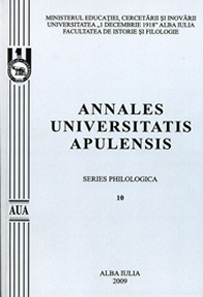Modernist and Postmodernist Deliniation of Characters
Modernist and Postmodernist Deliniation of Characters
Author(s): Marinela LupsaSubject(s): Literary Texts
Published by: Universitatea »1 Decembrie 1918« Alba Iulia
Keywords: delineation; multiplicity; intertextuality; innovation; modernist; characters; identity; realist
Summary/Abstract: For almost half a century, postmodernism has been a key term in the vocabulary of literary theory and practice. By the early 80’s the term shifted from a description of a range of aesthetic practices involving irony, selfconsciousness, fragmentation, parody, to a use which encompasses a general tendency in thought and which leads to a loss of faith in the discourses of modernity. Postmodernism is, in this respect, used to express the sense of a cultural epoch in which distributions between critical and functional knowledge break down, a sort of liberation from, or insight into, modernism and modernity. The term may be used in three broad senses: as a label used to designate the cultural epoch through which we are living, viewed in apocalyptic terms; as an aesthetic practice; as a development in thought which represents a critique of the assumptions of the Enlightenment or the discourses of modernity. The aestheticism of postmodernism includes a variety of forms; all of them express the sense that our inherited forms of knowledge are undergoing significant changes, certain strategies, stylistic and structural techniques and procedures. According to Docherty, “Postmodern figures are always differing, not just from other characters but also from their putative selves. Following in the wake of an existentialist philosophical tradition, many postmodern characterizations seem to argue that there is always a discrepancy between the character who acts and the character who watches himself/herself acting” (Docherty 1991:183). Characters in postmodernism fall into incoherence, namely character traits are not repeated but contradicted; proper names are used inconsistently. There is never a final point at which the character can be reduced to the status of an accessible quality or list of qualities; the notion of “representation” is being undermined in the process. Characters in the postmodernist novel partake in this way in the process of unmaking, disturbers of the ontological hierarchy of levels through their awareness of the structures they find themselves in. By means of parody, postmodernist writers create the mirror image of their main characters, questioning the reality of their fictional world or drawing attention to the fictionality of the world of fiction; the convention of characters defined in social and psychological terms is undermined. Consistent with its tendency for undermining narrative conventions, postmodernist fiction launches an attack on the notion of representation, in so far as it represents a dominant of character. Critics have argued that we can no longer speak about characters in postmodernist fiction, there can only be a matter of incoherence and fragmentation, of multiplicity and intertextuality where traditional fiction offered consistency and well-defined identity.
Journal: Annales Universitatis Apulensis. Series Philologica
- Issue Year: 11/2010
- Issue No: 2
- Page Range: 36-51
- Page Count: 16
- Language: English

